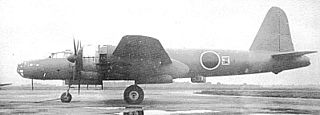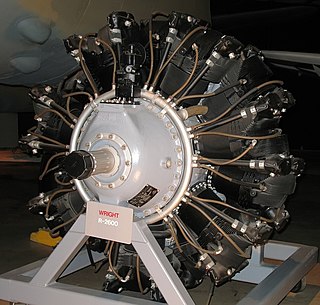
The Wright R-3350 Duplex-Cyclone is an American twin-row, supercharged, air-cooled, radial aircraft engine with 18 cylinders displacing nearly 3,350 cubic inches (54.9 L). Power ranged from 2,200 to 3,700 hp, depending on model. Developed before World War II, the R-3350's design required a long time to mature, and was still experiencing problems with reliability when used to power the Boeing B-29 Superfortress.

The Consolidated B-32 Dominator was an American heavy strategic bomber built for United States Army Air Forces during World War II, which had the distinction of being the last Allied aircraft to be engaged in combat during World War II; that engagement also resulted in the last American to die in air combat in World War II. It was developed by Consolidated Aircraft in parallel with the Boeing B-29 Superfortress as a fallback design should the B-29 prove unsuccessful. The B-32 reached units in the Pacific only in mid-May 1945, and subsequently saw only limited combat operations against Japanese targets before the formal end of the war on 2 September 1945. Most of the extant orders of the B-32 were canceled shortly thereafter and only 118 B-32 airframes of all types were built.

The Douglas XB-42 Mixmaster was an experimental American bomber aircraft, designed for a high top speed. The unconventional approach was to mount the two engines within the fuselage driving a pair of contra-rotating propellers mounted at the tail in a pusher configuration, leaving the wing and fuselage clean and free of drag-inducing protrusions.

The Beechcraft XA-38 "Grizzly" was a World War II-era ground attack aircraft, developed by Beechcraft, but never put into production. The Grizzly was to have been fitted with a forward-firing 75 mm cannon to penetrate heavily armored targets.

The Douglas A-20 Havoc is an American light bomber, attack aircraft, night intruder, night fighter, and reconnaissance aircraft of World War II.

The Boeing XB-15 was a United States bomber aircraft designed in 1934 as a test for the United States Army Air Corps (USAAC) to see if it would be possible to build a heavy bomber with a 5,000 mi (8,000 km) range. For a year beginning in mid-1935 it was designated the XBLR-1. When it first flew in 1937, it was the most massive and voluminous airplane ever built in the US. It set a number of load-to-altitude records for land-based aircraft, including carrying a 31,205 lb (14,154 kg) payload to 8,200 ft (2,500 m) on 30 July 1939.

The Douglas Y1B-7 was a 1930s American bomber aircraft. It was the first US monoplane given the B- 'bomber' designation. The monoplane was more practical and less expensive than the biplane, and the United States Army Air Corps chose to experiment with monoplanes for this reason. At the time the XB-7 was ordered, it was being tested by Douglas Aircraft as an observational plane.

The Douglas XB-19 was a four-engined, piston-driven heavy bomber produced by the Douglas Aircraft Company for the United States Army Air Forces (USAAF) during the early 1940s. The design was originally given the designation XBLR-2. It was the largest bomber built for the USAAF until 1946, with the Convair B-36 surpassing it in size.

The Douglas B-23 Dragon is an American twin-engined bomber developed by the Douglas Aircraft Company as a successor to the B-18 Bolo.

The Martin XB-27 was an aircraft proposed by the Glenn L. Martin Company to fill a strong need in the United States Army Air Corps for a high-altitude medium bomber. Its design was based approximately on that of Martin's own B-26 Marauder. The XB-27 remained on paper, and no prototypes were built.

The North American XB-28 (NA-63) was an aircraft proposed by North American Aviation to fill a strong need in the United States Army Air Corps for a high-altitude medium bomber. It never entered production, with only two prototypes being built.

The Lockheed XB-30 was the design submitted by Lockheed after the request by the United States Army Air Forces for a very heavy bomber, the same request that led to the Boeing B-29 Superfortress, the Douglas XB-31 and Consolidated B-32 Dominator.
The Douglas XB-31 was the design submitted by Douglas after the request by the United States Army Air Forces for a very heavy bomber aircraft, the same request that led to the Boeing B-29 Superfortress, Lockheed XB-30, and Consolidated B-32 Dominator.

The Nakajima G8N Renzan was a four-engined long-range bomber designed for use by the Imperial Japanese Navy. The Navy designation was "Type 18 land-based attack aircraft" (十八試陸上攻撃機); the Allied code name was "Rita".

The Wright R-2600 Cyclone 14 is an American radial engine developed by Curtiss-Wright and widely used in aircraft in the 1930s and 1940s.

The Boeing XB-39 Superfortress was a United States prototype bomber aircraft, a single example of the B-29 Superfortress converted to fly with alternative powerplants. It was intended to demonstrate that the B-29 could still be put into service even if the first choice of engine, the air-cooled Wright R-3350 radial engine, ran into development or production difficulties.

The Consolidated XB-41 Liberator was a single Consolidated B-24D Liberator bomber, serial 41-11822, which was modified for the long-range escort role for U.S. Eighth Air Force bombing missions over Europe during World War II.

The Curtiss XP-62 was a prototype single-engine interceptor aircraft, that was built for the United States Army Air Forces, by the Curtiss-Wright Corporation. It first flew in 1943.

The Lockheed C-69 Constellation is a four-engined, propeller-driven military transport aircraft developed during World War II. It was co-developed with the Lockheed Constellation airliner.

The North American NA-40 was an American prototype bomber aircraft developed by North American Aviation in the late 1930s for evaluation by the United States Army Air Corps. Although unsuccessful, it led directly to the North American B-25 Mitchell medium bomber.



















